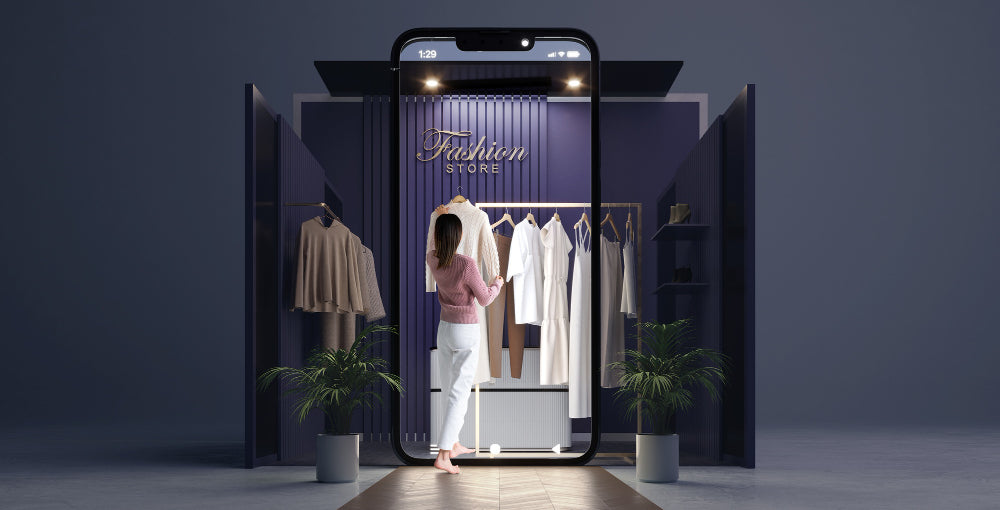How are AR/VR Fitting Rooms revolutionizing the Shopping Experience within the Fashion Industry?

The evolving fashion industry has always been at the forefront of innovation and change. As consumer expectations continue to rise, it has become increasingly important for fashion retailers to enhance the shopping experience. The way people shop for clothing and accessories is not just about the final purchase; it is about the entire journey, from browsing to trying on and making a decision. This evolving landscape calls for new and innovative solutions to meet the demands of modern consumers.
One such solution that has the potential to revolutionize the fashion industry is the concept of AR/VR fitting rooms. These cutting-edge technologies bring the virtual world into the physical retail space, providing customers with immersive and interactive experiences. AR/VR fitting rooms enable shoppers to virtually try on clothing and accessories, visualize different styles and colors, and even customize their virtual outfits. The fusion of augmented reality and virtual reality opens up a world of possibilities, transforming the way we shop for fashion.
I. The Current State of the Fashion Industry
The traditional fashion industry faces numerous challenges in providing a seamless shopping experience. From crowded stores to limited availability of sizes and styles, customers often find it difficult to navigate the physical shopping environment. Moreover, the traditional process of trying on clothes in physical fitting rooms can be time-consuming and frustrating, with long queues, inadequate lighting, and limited privacy. These challenges hinder the overall satisfaction of customers and create a gap between their expectations and the reality of the shopping experience.
The need for technological innovation has become evident in the fashion industry to bridge the gap between customer expectations and the current shopping experience. AR/VR fitting rooms offer a transformative solution that addresses these limitations and challenges. By using advanced technologies, retailers can enhance the shopping experience and provide customers with a more convenient, personalized, and engaging way to try on and select their fashion items. The integration of AR/VR fitting rooms in retail spaces has the potential to revolutionize the traditional fashion industry and meet the evolving demands of modern consumers.

II. Understanding AR/VR Fitting Rooms.
AR/VR fitting rooms are innovative technologies that combine augmented reality (AR) and virtual reality (VR) to create immersive and interactive experiences for customers trying on clothing and accessories. In AR/VR fitting rooms, customers wear AR/VR headsets or use mobile applications to superimpose virtual clothing and accessories onto their real-world image or enter a fully simulated virtual environment. Through sophisticated algorithms and computer vision, these technologies track body movements and allow customers to see themselves wearing different outfits and styles in real-time.
Virtual try-on technology, a key feature of AR/VR fitting rooms, offers numerous benefits to customers. Firstly, it enables them to visualize clothing and accessories without physically trying them on, saving time and effort. Customers can see how different garments fit and look on their own body, helping them make informed purchasing decisions. Virtual try-on also allows customers to experiment with various styles, colors, and combinations, enabling them to explore new fashion choices and discover their personal preferences. Moreover, virtual try-on technology fosters a more inclusive shopping experience, as it accommodates different body types and sizes, empowering customers to feel confident and comfortable with their choices.
Augmented reality in fashion and virtual reality in shopping are pivotal aspects of AR/VR fitting rooms. AR/VR fashion solutions encompass the range of technologies, tools, and software that facilitate the implementation of AR/VR fitting rooms in the fashion industry.
III. Transforming the Retail Landscape
a. How AR/VR fitting rooms are transforming the traditional retail experience.
AR/VR fitting rooms are revolutionizing the traditional retail experience in multiple ways. They provide a bridge between the online and offline shopping worlds, allowing customers to experience the benefits of e-commerce, such as virtual try-on and customization, within physical stores. By integrating AR/VR fitting rooms, retailers create a unique and memorable shopping environment that sets them apart from competitors and attracts tech-savvy customers. The integration of digital technologies into the physical retail space also enhances customer engagement, making the shopping journey more interactive, immersive, and enjoyable.
b. The role of augmented reality in creating immersive shopping experiences.
Augmented reality plays a crucial role in creating immersive shopping experiences through AR/VR fitting rooms. By overlaying virtual garments and accessories onto the customer's real-world image, augmented reality enhances the sense of presence and realism. Customers can see themselves wearing different outfits, view the clothing from multiple angles, and even experiment with virtual styling options. This interactive and engaging experience fosters a stronger emotional connection between customers and the fashion products, driving their interest and purchase intent.
c. The impact of virtual reality on customer engagement and satisfaction.
Virtual reality has a significant impact on customer engagement and satisfaction within AR/VR fitting rooms. By immersing customers in a fully simulated environment, virtual reality creates a captivating and transformative experience. Customers can explore virtual stores, interact with virtual assistants, and try on virtual garments in a way that feels realistic and enjoyable. This heightened level of engagement enhances customer satisfaction, as they can fully visualize and experience the fashion products in a context that aligns with their personal style and preferences.
The integration of AR/VR fitting rooms also relies on the use of 3D product modeling. By creating accurate and detailed virtual representations of clothing items through 3D modeling, retailers can showcase their products in a visually compelling way. 3D product modeling enables customers to examine the intricate details, textures, and patterns of garments, providing a more realistic and informative shopping experience. This technology contributes to enhanced virtual shopping by ensuring that customers can make informed decisions based on accurate representations of the fashion products. Furthermore, 3D product modeling drives fashion industry innovation by pushing the boundaries of creativity and design, offering new possibilities for virtual fashion experiences, and paving the way for future advancements in the clothing industry.

IV. Enhancing the Shopping Experience.
AR/VR fitting rooms offer numerous advantages in terms of convenience and accessibility. With traditional physical fitting rooms, customers often face long queues and limited availability, leading to frustration and time wastage. However, AR/VR fitting rooms eliminate these challenges by allowing customers to try on virtual garments and accessories without the need for physical items. This convenience enables shoppers to browse through a wide range of products in a shorter amount of time, enhancing the overall shopping experience.
a. How virtual try-on technology empowers customers to make more informed purchasing decisions.
Virtual try-on technology is a game-changer when it comes to making informed purchasing decisions. By leveraging AR/VR fitting rooms, customers can visualize how clothing items will look and fit on their own bodies. This empowers them to assess the suitability and style of the garments before making a purchase. Virtual try-ons reduce the risk of buying ill-fitting or unflattering items, resulting in higher customer satisfaction and reduced returns. It also enables customers to explore different combinations and experiment with styles, encouraging creativity in their fashion choices.
i. AR/VR fitting rooms offer a transformative user experience that goes beyond traditional shopping methods. By leveraging custom 3D models, these fitting rooms provide highly realistic virtual representations of fashion products.
ii. Customers can explore garments and accessories in intricate detail, examining textures, finishes, and even the stitching. This level of detail contributes to a more immersive and engaging shopping experience.
iii. Augmented marketing is another area where AR/VR fitting rooms excel. Brands can leverage these technologies to create innovative and captivating marketing campaigns. They can showcase their products in unique and interactive ways, creating memorable experiences for customers. Augmented marketing campaigns generate excitement and buzz, elevating brand visibility and attracting new customers.
b. The role of customization and personalized experiences in the fashion industry.
Customization and personalized experiences have become increasingly important in the fashion industry. AR/VR fitting rooms facilitate these trends by allowing customers to customize their virtual try-on experiences. They can adjust garment sizes, change colors and patterns, and even mix and match different items to create unique outfits. This level of customization enhances the sense of personalization and individuality, catering to the diverse preferences and style choices of customers. It fosters a deeper connection between customers and the brands, leading to increased brand loyalty and customer engagement.
V. Fashion Revolution: The Future of Shopping
AR/VR fitting rooms have the potential to revolutionize the fashion industry. By merging technology with fashion, these fitting rooms offer a new dimension to the shopping experience. They break down physical limitations and geographical boundaries, allowing customers to explore global fashion trends and styles without leaving their homes. The fashion revolution brought about by AR/VR fitting rooms is reshaping the way customers interact with fashion, making it more accessible, engaging, and inclusive.
The implications of AR/VR technology on global fashion trends and consumer behavior are profound. Virtual try-on experiences enable customers to explore and adopt diverse styles that may not have been readily available to them previously. The ease of experimentation and the ability to discover new brands and designs contribute to the democratization of fashion. Moreover, AR/VR technology facilitates seamless integration between online and offline retail, providing a unified and consistent shopping experience for customers.
AR/VR technology enables international collaborations and connections, bridging the gap between designers, manufacturers, and consumers. Through 3D product modeling services, fashion brands can create virtual replicas of their physical garments, making them accessible to customers worldwide. In this way international fashion fosters cultural exchange and diversity within the industry.

VI. The Role of my3dmodels in Fashion Innovation
Customized 3D models and assets are essential components in the success of AR/VR fitting room experiences, and my3dmodels excels in their creation. Through their meticulous attention to detail, my3dmodels achieves several key contributions to the fitting room experience:
a. Creating realistic virtual representations of fashion products to accurately replicate the visual appearance of real garments. This attention to realism enables customers to have an immersive and lifelike experience when trying on virtual clothing items in AR/VR fitting rooms.
b. Showcasing the intricate details and textures of clothing items is not just about the overall design but also about the intricate details that make each garment unique. Their 3D models and assets showcase these details, including intricate patterns, textures, stitching, and embellishments, ensuring that customers can fully appreciate the craftsmanship and quality of the virtual garments.
c. Enabling accurate virtual try-ons and customization options ensures that their 3D models and assets accurately represent the fit and shape of the garments. This level of accuracy allows customers to make informed decisions about sizing, ensuring that the virtual try-on experience closely mirrors the real-life fit. Additionally, my3dmodels' customized 3D models support various customization options, such as adjusting garment colors, patterns, or even fabric types, providing customers with a truly personalized and interactive fitting room experience.
VII. Conclusion
In conclusion, my3dmodels holds a pivotal role in fashion innovation, particularly in the realm of AR/VR fitting rooms. Their expertise in creating high-quality 3D models and assets enhances the overall shopping experience by providing realistic virtual representations of fashion products. Through showcasing intricate details and enabling accurate virtual try-ons and customization options, my3dmodels empowers customers to make informed purchasing decisions and fosters a deeper connection between brands and consumers.
As the fashion industry continues to embrace technology, AR/VR fitting rooms are set to revolutionize the shopping experience. my3dmodels' commitment to delivering exceptional 3D modeling services ensures that they are at the forefront of this transformative change. With their contributions to the fashion industry, my3dmodels drives innovation, supports brand growth, and shapes the future of fashion by seamlessly integrating technology and enhancing the way we shop.
-
Posted in
3d asset, 3d model, AR/VR, Augmented reality, Fashion, Fashion global, Fitting rooms, User expereince, virtual reality




